| View previous topic :: View next topic |
| Author |
Message |
bob kerr

Joined: 13 Nov 2011
Posts: 537
Location: Monroeville PA



|
 Posted: Jan 19, 2023 21:59 Post subject: Unique Schorl Double Terminations Posted: Jan 19, 2023 21:59 Post subject: Unique Schorl Double Terminations |
|
|
There's a few double terminated schorls from Erongo that have been around for a while that have two unique terminations. One side is smooth and typical - and the other side can best be described as "rough" or hundred of small termination. See photos.
Is there a name for this type of double terminations?
thanks,
bob
| Mineral: | Schorl |
| Locality: | | Erongo Region, Namibia |  |
|
| Description: |
| the "smooth "termination end |
|
| Viewed: |
10162 Time(s) |
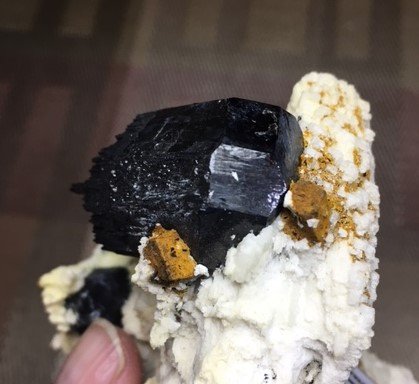
|
| Mineral: | Schorl |
| Locality: | | Erongo Region, Namibia |  |
|
| Description: |
| the "rough" or multi terminated end |
|
| Viewed: |
10146 Time(s) |
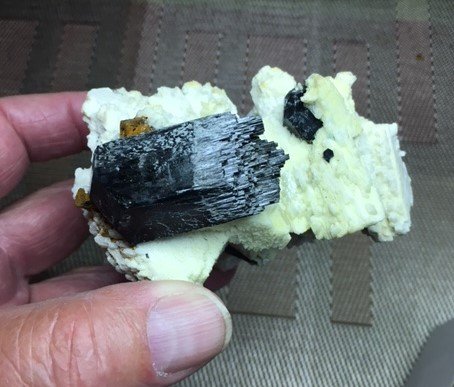
|
|
|
| Back to top |
|
 |
Matt_Zukowski
Site Admin
Joined: 10 Apr 2009
Posts: 707
Location: Alaska



|
 Posted: Jan 19, 2023 22:11 Post subject: Re: Unique Schorl Double Terminations Posted: Jan 19, 2023 22:11 Post subject: Re: Unique Schorl Double Terminations |
|
|
| Maybe it is just preferential dissolution of the basal pinacoid.
|
|
| Back to top |
|
 |
Philippe Durand
Joined: 10 May 2016
Posts: 628
Location: Normandie



|
 Posted: Jan 20, 2023 01:22 Post subject: Re: Unique Schorl Double Terminations Posted: Jan 20, 2023 01:22 Post subject: Re: Unique Schorl Double Terminations |
|
|
Interesting subject
I have a french schorl with the same configuration
and I always ask myself if it is dissolution or primary termination
I remember seeing beryls with this type of termination too
_________________
https://www.youtube.com/user/ptitrainrouge/videos?view_as=subscriber |
|
| Back to top |
|
 |
Herman van Dennebroek

Joined: 07 Feb 2011
Posts: 87
Location: Blaricum



|
 Posted: Jan 20, 2023 04:16 Post subject: Re: Unique Schorl Double Terminations Posted: Jan 20, 2023 04:16 Post subject: Re: Unique Schorl Double Terminations |
|
|
| bob kerr wrote: | There's a few double terminated schorls from Erongo that have been around for a while that have two unique terminations. One side is smooth and typical - and the other side can best be described as "rough" or hundred of small termination. See photos.
Is there a name for this type of double terminations?
thanks,
bob |
Paul Rustemeyer, describes in his book “Faszination Turmalin Formen Farben Strukturen’’ on page 122 this kind of turmaline. Litlle mistakes in the crystal grid causes this form. He speaks of “Aufspaltung” (split open) of the mother crystal in various daughter crystals, which grow parallel further . When the crystals continue to grow each daughter gets her own top plane. This phenomenon is well known from the Erongomountains.
_________________
boardmember of Stichting Geologische Aktiviteiten (GEA) |
|
| Back to top |
|
 |
lluis
Joined: 17 Nov 2006
Posts: 711


|
 Posted: Jan 20, 2023 07:59 Post subject: Re: Unique Schorl Double Terminations Posted: Jan 20, 2023 07:59 Post subject: Re: Unique Schorl Double Terminations |
|
|
I think that the "moor heads" tourmaline from Elba (and probably from more places....) have the same shape. As far as I remember and have read, the black caps are not elbaite, but povondraite. And I have also read and told to me personally Dr. Joan Viñals that many black tourmalines named Schorl could very well be povondraites...
If that serves for anything....
With best wishes
Lluís
|
|
| Back to top |
|
 |
Roger Warin

Joined: 23 Jan 2013
Posts: 1176



|
 Posted: Jan 20, 2023 08:15 Post subject: Re: Unique Schorl Double Terminations Posted: Jan 20, 2023 08:15 Post subject: Re: Unique Schorl Double Terminations |
|
|
Hello,
In Schorl, there is no pinacoid (2 parallel faces) but 2 pedions (single face) because there is no center of symmetry in the crystal.
The lower base is called the analogous pole, the upper top is the antilogous pole.
Photos are difficult to interpret. My opinion is that the analogous pole corresponds to the 1st photo, while the antilogous pole would be the second photo. This would be the termination with a parallel growth of fine crystals.
The analogous pole is generally poorer in facets than the antilogous pole.
The analogous pole is generally less steep.
Here is an example described by Lacroix on a tourmaline from Betroka, Madagascar.
| Description: |
|
| Viewed: |
9958 Time(s) |
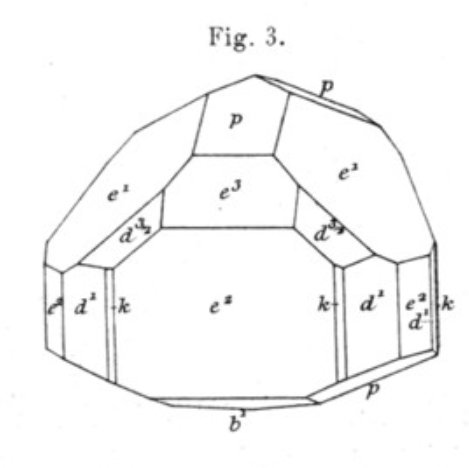
|
|
|
| Back to top |
|
 |
Bob Morgan
Joined: 18 Jan 2018
Posts: 228
Location: Savannah, Georgia



|
 Posted: Jan 21, 2023 15:36 Post subject: Re: Unique Schorl Double Terminations Posted: Jan 21, 2023 15:36 Post subject: Re: Unique Schorl Double Terminations |
|
|
This crystal appears to have developed in both directions at the same time due to its attachment on one side.
Another possible explanation is that an impurity was deposited selectively on the growing face of one end that resulted in splitting of the crystal.
|
|
| Back to top |
|
 |
bob kerr

Joined: 13 Nov 2011
Posts: 537
Location: Monroeville PA



|
 Posted: Jan 21, 2023 22:57 Post subject: Re: Unique Schorl Double Terminations Posted: Jan 21, 2023 22:57 Post subject: Re: Unique Schorl Double Terminations |
|
|
My apologies for the poor photo quality. Here's a photo that I think better shows the two terminations. The "smooth" side to the right in the photo is very typical for tourmalines and the opposite termination (rough) to the left in the photo may indeed be many, many smaller terminations. Some thoughts:
- Note about 1/3 of the way from the left of the crystal the sides transition to smooth
- the crystals are typically all the same size and kind of stubby
- assuming the crystal started growing surrounded by the same fluids, something occurred that changed the characteristics of the termination - ??
- is there a technical term for this termination characteristic?
thanks for the thoughts so far,
bob
| Mineral: | Schorl |
| Locality: | | Erongo Region, Namibia |  |
|
| Description: |
|
| Viewed: |
9791 Time(s) |
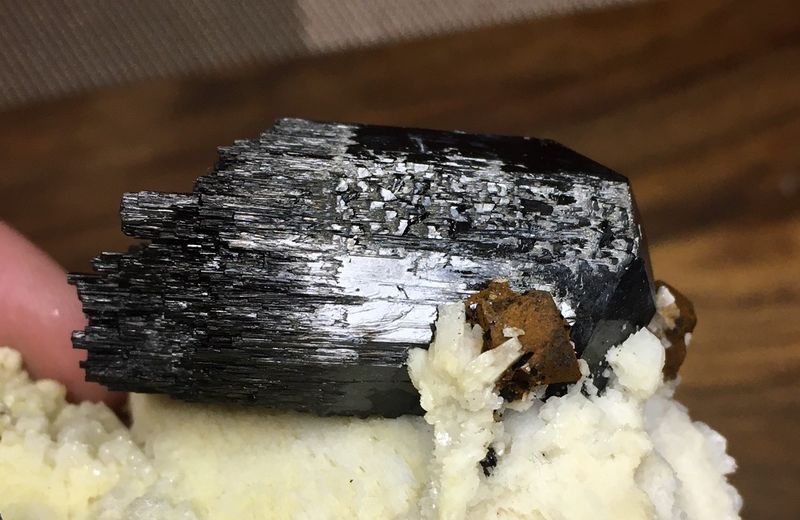
|
|
|
| Back to top |
|
 |
Roger Warin

Joined: 23 Jan 2013
Posts: 1176



|
 Posted: Jan 22, 2023 03:23 Post subject: Re: Unique Schorl Double Terminations Posted: Jan 22, 2023 03:23 Post subject: Re: Unique Schorl Double Terminations |
|
|
Yes, I agree.
But we must take into account the kinetics of growth.
The smallest Miller index faces are those with the highest reticular densities (highest atom densities) and are therefore those that grow the slowest (given the need to assemble many atoms to finalize the growing side).
It is therefore quite natural that these faces predominate in crystalline structures.
So, as the analogous pole carries the truncations (Lacroix)
Analog pole: p (10.1) b1 (01.2)
it grows less quickly than the antilogous pole bearing steeper faces with larger indices:
e1 (02.1) p (10.1) e3 (40.3) d2 (21.1) d3/2 (32.1)
In the growth of the crystal, 2 factors intervene,
1) the atomic (reticular) density of the face.
2) the accessibility of the mother solution to the crystallization site, which directly depends on the speed of deposition: rapid growth gives skeletal crystals (eg. snow crystals) favoring the tops and edges at the expense of the core of the face.
It's a logistical problem like in horrible war.
Bob, can you say what is the termination at the top of the little crystals?
Very nice photos of a case that I have never observed.
|
|
| Back to top |
|
 |
bob kerr

Joined: 13 Nov 2011
Posts: 537
Location: Monroeville PA



|
 Posted: Jan 22, 2023 10:44 Post subject: Re: Unique Schorl Double Terminations Posted: Jan 22, 2023 10:44 Post subject: Re: Unique Schorl Double Terminations |
|
|
I do not have a real good camera that is capable of close-focus - here's about the best I can do right now.
But - looking at these "rough" terminations through a 10x loop it is clear that all the small terminations are indeed "rough" - either never terminated cleanly to begin with or damaged in shipment or damaged while collecting in the mine.
But it seems a few of the terminations in more protected vugs should be clean if they were clean to begin with - however this is not the case.
bob
| Mineral: | Schorl |
| Locality: | | Erongo Region, Namibia |  |
|
| Description: |
|
| Viewed: |
9637 Time(s) |
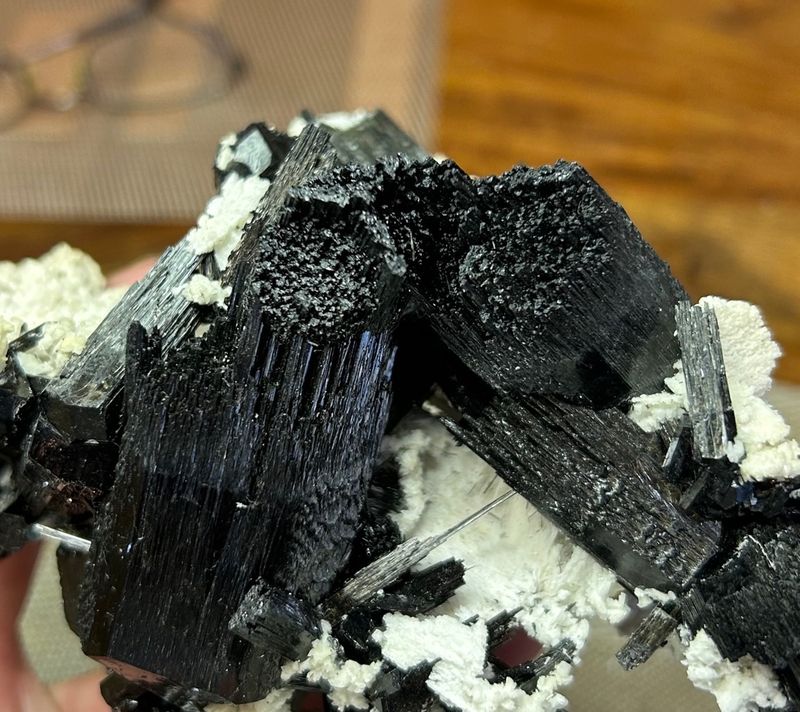
|
|
|
| Back to top |
|
 |
Bob Morgan
Joined: 18 Jan 2018
Posts: 228
Location: Savannah, Georgia



|
 Posted: Jan 22, 2023 19:47 Post subject: Re: Unique Schorl Double Terminations Posted: Jan 22, 2023 19:47 Post subject: Re: Unique Schorl Double Terminations |
|
|
Looking through the photos in mindat, I believe this is a product of skeletal growth in tourmaline.
Schorls from, Namibia show a variety of growth features. Some are a product of very fast spherocytic growth. Others show splitting on one end - photos 536005, 20690, and328789.
Then there are those that have split ends without the ends diverging outward like the specimen you have.
An earlier stage of skeletal growth can be viewed in photos 928103 and854368.
More developed such growth is shown in photos 388512,2378982-4, and 338444.
Then there some resembling your specimen in photos 143213 and 332040.
I suspect there is some etching of the split ends. It wouldn't have to be extensive to render the small terminations as indefinite. I have a similar specimen and the sides of the small crystals are still shiny. Also, light shines moreso off the plane roughly perpendicular to the c-axis.
A more extreme skeletal crystal is in photo 391851.
One indicator that the basic shape is not due to extensive etching is that in photos 431915 and 41146 two crystals side by side show the splitting in opposite directions and matrix nearby seem unaffected.
This sems to be the tourmaline development similar to skeletal quartz with threeway ridges at the termination.
I hope this helps. You have quite a lovely demonstration of this habit.
|
|
| Back to top |
|
 |
Roger Warin

Joined: 23 Jan 2013
Posts: 1176



|
 Posted: Jan 22, 2023 23:41 Post subject: Re: Unique Schorl Double Terminations Posted: Jan 22, 2023 23:41 Post subject: Re: Unique Schorl Double Terminations |
|
|
Hello,
This comment helps me too.
Because we know (although it still surprises me) that the crystallization of pegmatite minerals is very fast.
The unit of the abscissa axis giving the growth rate is of the order of a week and even less. A 1 m long quartz crystal can form in 1 day!
These conditions are favorable for skeletal growth.
The unit on the abscissa varies from milliseconds to 1 million years.
The growth of garnets is slow.
|
|
| Back to top |
|
 |
bob kerr

Joined: 13 Nov 2011
Posts: 537
Location: Monroeville PA



|
 Posted: Jan 23, 2023 10:28 Post subject: Re: Unique Schorl Double Terminations Posted: Jan 23, 2023 10:28 Post subject: Re: Unique Schorl Double Terminations |
|
|
I was chatting with Rocko Rosenblatt about these, and he says they're foitite. I looked in mindat and found it described as:
"Rod-like crystals with the common prisms and pyramids of the tourmaline group."
but it doesn't mention these different terminations.
I'm not sure if these specimens form in one direction as schorl and the other as foitite??
Anyway, pretty unique material.
bob
|
|
| Back to top |
|
 |
Bob Morgan
Joined: 18 Jan 2018
Posts: 228
Location: Savannah, Georgia



|
 Posted: Jan 23, 2023 11:12 Post subject: Re: Unique Schorl Double Terminations Posted: Jan 23, 2023 11:12 Post subject: Re: Unique Schorl Double Terminations |
|
|
Several photos of foitite from Namibia show the foitite end as light to white. Also, the site says it takes a chemical confirmation for foitite.
If yours is foitite on that end, the change from shorl would probably be subtle given the relative same composition of the two minerals.
Finally, there are some photos of less hairlike single crystals of foitite and none that have them bunched as on the termination of the shorl without the shorl connection.
A chemical analysis would be the only way to confirm or rule out that option.
Getting that would probably inform a number of collectors who have similar specimens. I hope you will get that.
|
|
| Back to top |
|
 |
lluis
Joined: 17 Nov 2006
Posts: 711


|
 Posted: Jan 23, 2023 12:11 Post subject: Re: Unique Schorl Double Terminations Posted: Jan 23, 2023 12:11 Post subject: Re: Unique Schorl Double Terminations |
|
|
I correct myself...
When I said povondraite,I wish to tell "foitite"
With best wishes
Lluís
|
|
| Back to top |
|
 |
bob kerr

Joined: 13 Nov 2011
Posts: 537
Location: Monroeville PA



|
 Posted: Jan 23, 2023 22:40 Post subject: Re: Unique Schorl Double Terminations Posted: Jan 23, 2023 22:40 Post subject: Re: Unique Schorl Double Terminations |
|
|
I may be able to get an analysis of these in a few months and will report back.
In the meantime - here's a photo of the "rough" terminations of another of these specimens (with aquamarine). Note the "attempt to terminate in the "typical" tourmaline form" (sorry, don't know what else to call this).
stay tuned,
bob
| Mineral: | Schorl |
| Description: |
|
| Viewed: |
9335 Time(s) |
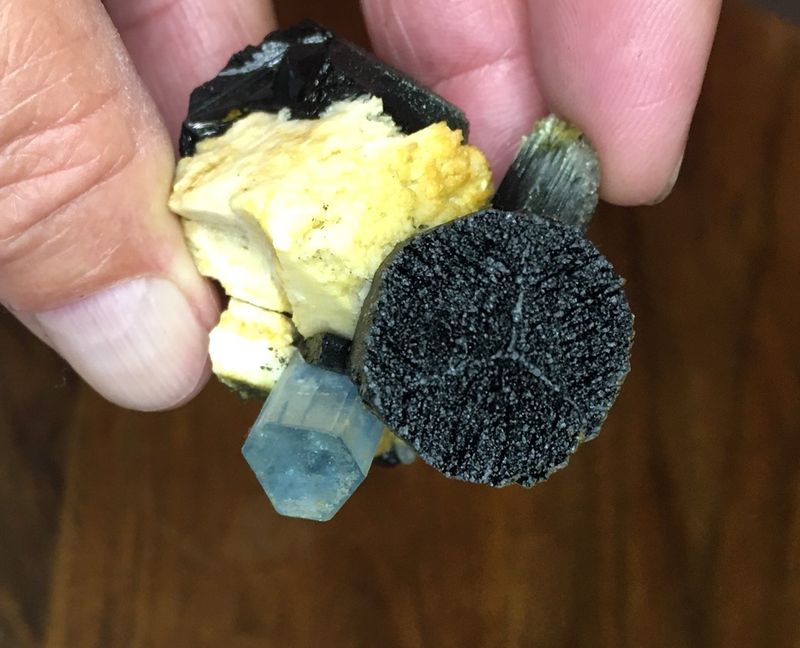
|
|
|
| Back to top |
|
 |
Roger Warin

Joined: 23 Jan 2013
Posts: 1176



|
 Posted: Jan 24, 2023 14:28 Post subject: Re: Unique Schorl Double Terminations Posted: Jan 24, 2023 14:28 Post subject: Re: Unique Schorl Double Terminations |
|
|
For me, the head of the crystal is not rough but demonstrative.
This is still fast growing because edges grow faster than faces.
The Mercedes Cross highlights the ternary c axis of the tourmaline.
The axis grows faster than its neighbors and the edges are also highlighted.
It remains to determine what is the dihedral angle between the two faces that these 3 edges separate. You need at least a big magnifying glass. I could take a picture, but my binocular is far from the crystal...
I am inclined to think that it is the antilogous pole which is for me (so this is only an opinion), the pole of faster growth than the lower pole called analogous (non-symmetrical). This is the basis (in the literary sense) of the prism.
So I tend to say that tourmaline “grows like a leek” and does not stretch downwards!
|
|
| Back to top |
|
 |
Roger Warin

Joined: 23 Jan 2013
Posts: 1176



|
 Posted: Jan 25, 2023 06:14 Post subject: Re: Unique Schorl Double Terminations Posted: Jan 25, 2023 06:14 Post subject: Re: Unique Schorl Double Terminations |
|
|
Hello,
I warmly thank Bob Kerr for pulling a magnificent specimen out of his conjurer's hat.
Having spent my life as a researcher-teacher (chemistry), I have often explored borders to understand Nature.
Thanks to Bob, I am writing a story for the youngsters of my club (www.AGAB.be) on the growth of tourmaline.
I rummaged through my dusty drawers and found a Schorl with the wrong label (Pakistan). I bought this small specimen from an exhibitor in Eastern Europe, in Liege (Belgium) at Interterminéral 2000, in November. Obviously, it comes from Erongo.
Not being sexy, this specimen remained in the dust-free drawer for 22 years.
But today what a nice surprise, I found the beginning of a new story.
I present 2 pictures:
1) Ordinary photo.
2) Ditto, with high magnification, since the photo has a FOV = 1.3 mm.
I will thus illustrate the growth of tourmaline, taking into account its structure with multiple cations (more tomorrow maybe).
| Mineral: | Tourmaline var Schorl |
| Locality: | | Erongo Mountain, Usakos, Erongo Region, Namibia |  |
|
| Dimensions: | 4.5 cm |
| Description: |
|
| Viewed: |
9164 Time(s) |
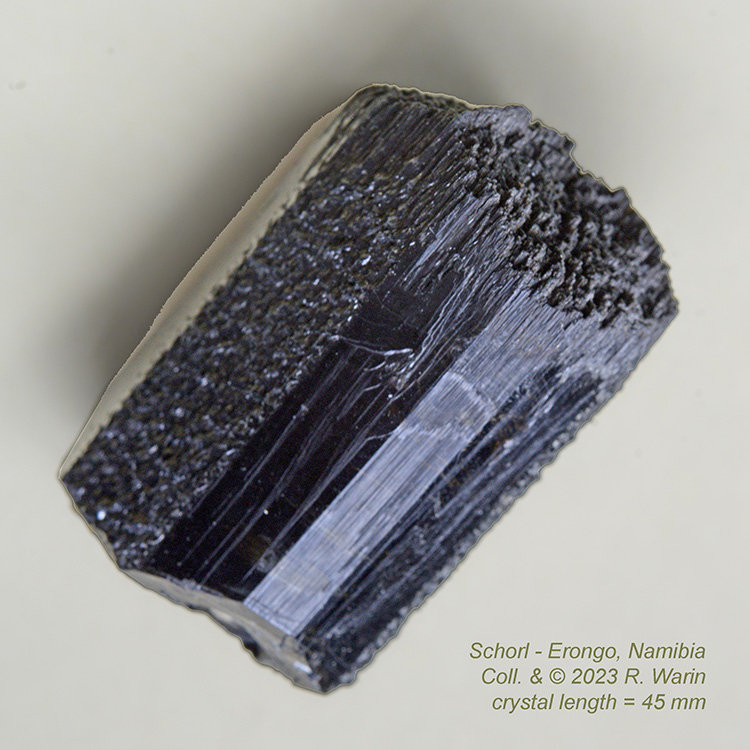
|
| Mineral: | Tourmaline var Schorl |
| Description: |
|
| Viewed: |
9173 Time(s) |
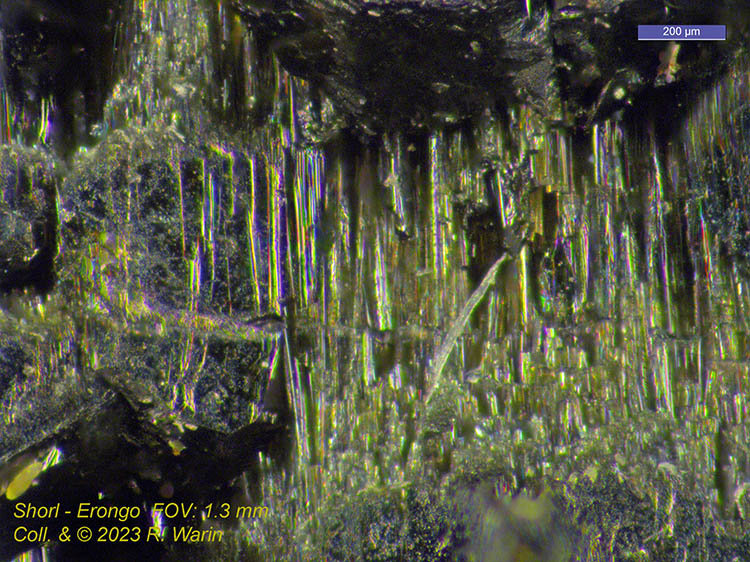
|
|
|
| Back to top |
|
 |
Peter Lemkin
Joined: 18 Nov 2016
Posts: 398
Location: Prague


|
 Posted: Jan 25, 2023 06:19 Post subject: Re: Unique Schorl Double Terminations Posted: Jan 25, 2023 06:19 Post subject: Re: Unique Schorl Double Terminations |
|
|
| I have one of these schorl from Erongo and have seen many being sold. They all seem to be the same - one 'normal' termination and the other side having what seems [to me] to be hundreds of parallel epitactic smaller xx. Someone must have written a paper on this already [my guess]...I'll see if I can find one, as this interests me too for my specimen. If unique, I might even buy some others - they are regularly offered at shows and I have avoided buying the largest and best, as I didn't know what was really going on.
|
|
| Back to top |
|
 |
Roger Warin

Joined: 23 Jan 2013
Posts: 1176



|
 Posted: Jan 26, 2023 15:42 Post subject: Re: Unique Schorl Double Terminations Posted: Jan 26, 2023 15:42 Post subject: Re: Unique Schorl Double Terminations |
|
|
Hello,
Paraphrasing the words of Pete Richards, I would say that all chemistry and biochemistry obey these laws:
I find the shapes of crystals to be among the most elegant manifestations of the self-organizing principles of our world!
Pete once answered on the subject of tourmaline epitaxy, on this forum (Posted Apr 23, 2022 00:53 Post subject: Re: Tourmaline - Quartz epitaxy?).
I really like this growth differentiation of some Schorls from Erongo.
I had never seen such a photo as the one I just took.
The appearance of the different faces of the prisms of this tourmaline facilitates morphological analysis since the ridges on the top allow the crystal to be oriented.
Erongo Schorl can undergo modifications at the end of growth which are not epitaxies but parallel growths in the final phase following a change in the composition of the mother liquors.
I explain this phenomenon by a loss of iron at the end of crystallization, with a very weak extension of the Schorl (without iron) in tourmaline (elbaite perhaps) over a few hundred microns. These local extensions of the Schorl become yellowish-green, almost colorless.
What is your opinion ?
| Mineral: | Tourmaline var Schorl |
| Description: |
|
| Viewed: |
8987 Time(s) |
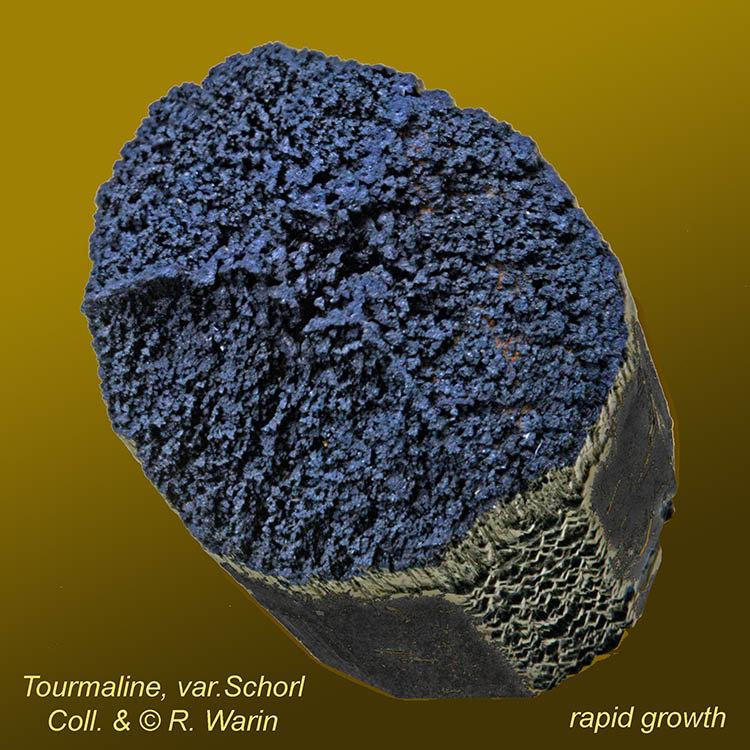
|
| Mineral: | Tourmaline var Schorl |
| Description: |
|
| Viewed: |
8978 Time(s) |
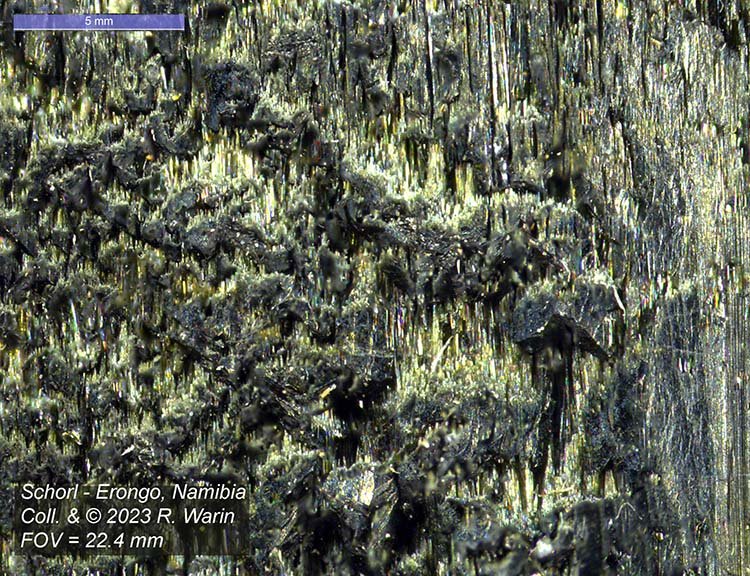
|
| Mineral: | Tourmaline var Schorl |
| Description: |
|
| Viewed: |
8983 Time(s) |
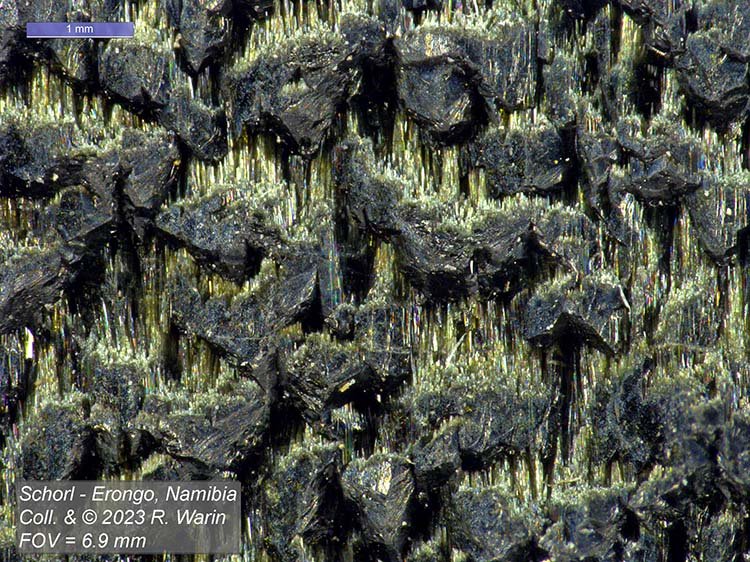
|
| Mineral: | Tourmaline var Schorl |
| Description: |
|
| Viewed: |
8958 Time(s) |
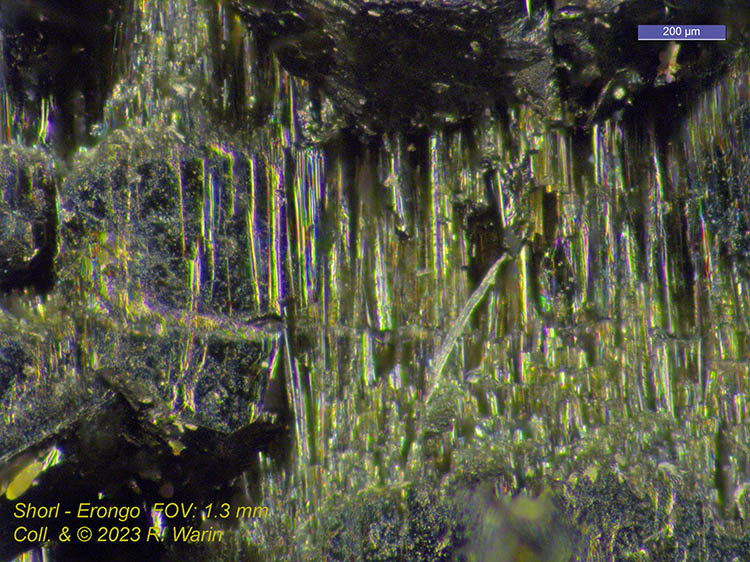
|
|
|
| Back to top |
|
 |
|



